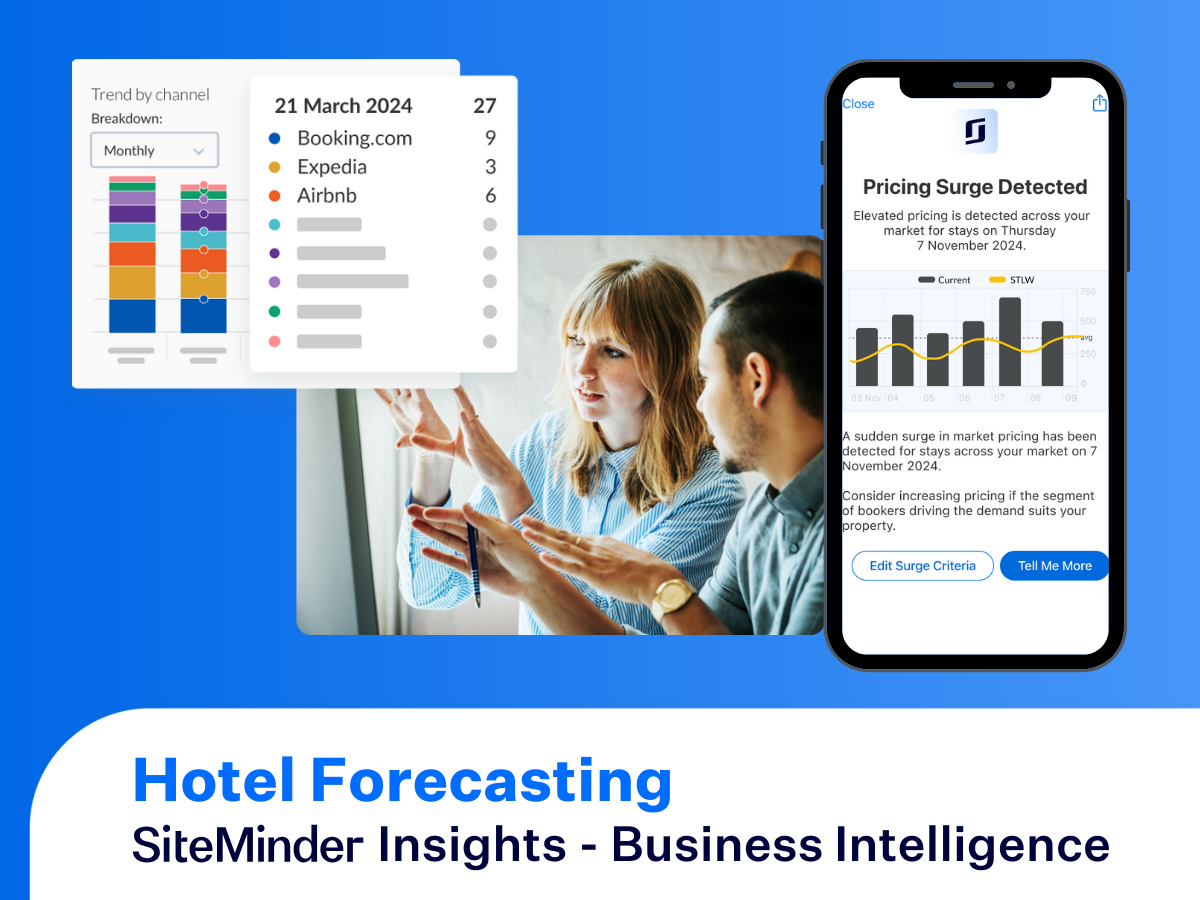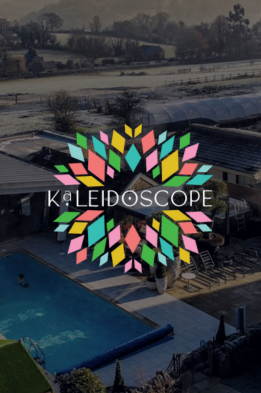What is hotel forecasting?
Hotel forecasting is a method that is used to help managers determine their accommodation’s future demand and revenue performance.
By analysing past and present data, hotel forecasting enables you to predict future outcomes and gives you the opportunity to correct past mistakes, maximise profit, and be prepared for disruptions or unforeseen events.
As unpredictable as it can be at times, especially after the COVID-19 pandemic, forecasting is still an important part of running a hotel and being able to make strategic revenue management decisions.
Whether you’re a seasoned hotelier or new to the industry, understanding the nuances of forecasting can be a game-changer for your business.
Table of contents
What is a hotel availability forecast?
A hotel availability forecast is a predictive tool used by hoteliers to estimate the number of rooms that will be available for sale over a specific period. This forecast takes into account the total number of rooms in the hotel and subtracts the number of rooms that are expected to be occupied.
The result gives hotel managers an idea of how many rooms they can still sell, allowing them to make informed decisions about pricing, promotions, and distribution.
The importance of forecasting in the hotel industry
You need to use forecasting at your hotel to inform your pricing and revenue strategies. Without undertaking accurate hotel forecasting, you’ll have no accuracy when it comes to predicting your future booking volume.
Without a forecast, you’ll also be flying blind as you plan and implement your rates, promotions, and packages for the upcoming months.
A good hotel forecast will help you make the most of peak periods and help you through low periods easier.
Precise forecasting, less work Make smarter decisions for your hotel with SiteMinder’s real-time data.
How to read revenue forecast report in hotels
Your hotel revenue report offers a detailed look into the monetary health of your hotel, including its current performance, its opportunities, and its challenges.
Whether you’ve been in the hotel business for decades or are charting your first course, decoding this report is essential for steering your establishment towards growth and profitability. Here’s how to get started:
Understand key metrics
Average Daily Rate (ADR), Revenue Per Available Room (RevPAR), and Total Revenue are essential metrics included in comprehensive revenue forecast reports. Knowing what each metric represents will provide a clearer picture of your hotel’s performance and areas of improvement.
Analyse historical data
Historical data serves as a foundation for forecasting. By examining past revenue trends, seasonal fluctuations, and guest preferences, you can predict future demand more accurately. This analysis also helps in identifying patterns and anomalies that might affect future revenue.
Segment market
Market segmentation involves categorising your target audience based on various criteria like demographics, booking channels, or purpose of visit. By understanding which segments bring in the most revenue, you can tailor your marketing and pricing strategies to attract and retain these valuable customers.
Demand forecast
Anticipating future demand is crucial for setting room rates and promotional offers. By analysing booking trends, event calendars, and market conditions, you can estimate the number of guests expected during a particular period, allowing for better inventory and pricing management.
Occupancy rate
The occupancy rate indicates the percentage of rooms occupied over a specific period. A higher occupancy rate often signifies robust demand, while a lower rate might indicate the need for promotional activities or rate adjustments. Monitoring this rate regularly can guide your revenue management decisions.
External factors and trends
Beyond internal data, it’s essential to be aware of external factors that might influence your hotel’s revenue. In your forecast report, this may include local and global economic conditions, local events, competitor activities, and emerging travel trends. Staying updated with these factors ensures that your revenue forecast is both comprehensive and accurate.

How to forecast hotel revenue effectively
The outcome of your forecasting should always be the ability to react to market changes, optimise occupancy, and maximise revenue.
Doing this effectively means you have to consider a number of factors such as key revenue metrics like occupancy, room nights, and average daily rates; but also staff allocation and resourcing.
The more data you can gather, the less uncertainty you’ll have and the stronger your plans will become. However it’s important to remember that your hotel forecast should not be static.
You should perform weekly or monthly reviews as new information comes to hand and constantly measure performance, looking at what went right and wrong. This allows you to make adjustments to your strategy and update your forecasts to drive even better results.
The basis for hotel forecasting should be historical performance and market trends. With these you can draw conclusions about what you missed, what you can expect, and how you can improve in the next month, quarter, or year.
Hotel forecasting methods to use
A simple hotel forecasting model that your hotel can get started on is to use purely historical data to predict future outcomes.
For example, you could single out a particular month and look at:
- How many room nights were sold
- Your occupancy rate
- Your average daily rate
- Your total revenue
- Average length of stay
- Booking lead times
Based on this you could predict similar numbers for the same month the next year, and strategies on how you improve your performance and boost profit.
A more advanced hotel forecasting model that your hotel can use is to also look at data based on segmentation in addition to the basic metrics above.
This means taking into consideration things like group bookings or demand driven by abnormal circumstances.
For example, if a company booked a corporate trip as a once-off, you know you can’t rely on that larger than normal influx of occupancy or revenue the next year. So you would need to look at ways you could fill the gap in room nights or earn more revenue from the other predicted bookings.
Going further, to completely flesh out your revenue management forecasting, you should also take competitor pricing and overall market performance into account. This will allow you more clarity and flexibility when it comes to setting your rates.
For instance, you might want to set seasonal prices, target new demographics, implement new promotions, or market your property on a comparative basis to beat your competitors.
Understanding demand forecasting in the hotel industry
Demand forecasting is vital to predict guest numbers, optimising strategies for pricing, staffing, and marketing. Here’s a brief overview:
- Historical data. Analyse past bookings and guest trends to predict future demand.
- Market segments. Understand categories like business travellers or leisure guests to tailor strategies.
- Booking pace. Track the rate of reservations to gauge increasing or decreasing demand.
- Special events & holidays. Stay updated with local events and holidays that can spike demand.
- External factors. Consider influences like economic conditions or political events that might affect bookings.
- Technology. Use advanced tools for more accurate, automated forecasting.
Mastering demand forecasting helps you make informed decisions, ensuring profitability and guest satisfaction.
Hotel revenue forecasting best practices
When compiling your data and establishing your hotel forecasts, it’s crucial that everything is as accurate as possible and that all data points have been accounted for.
Remember the following:
- Past performance data and historical market trends
- Current hotel data such as current reservations, confirmed upcoming promotions or marketing campaigns, and website traffic and conversions
- Current market trends such as increases or declines in arrivals to your destination or increases/declines from particular source markets
- Ensure good quality data is collected, including specific channel performance, travel types (business or leisure for example), guest demographics, and drilled down metrics like RevPAR
- Always take events, holidays, and global conditions into account
- Review your performance and forecasts in conjunction regularly so you can make quick and effective decisions
- Consider competitor performance as part of your calculations
- Compare your share of new bookings vs repeat bookings to help define your strategy
- Work hard to reduce data errors such as incorrect segmentation, duplicate bookings, pending reservations, overbookings, or incorrect rate mapping or reservation dates

